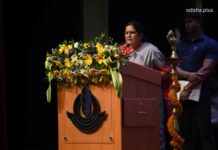Media as the fourth arm of the Constitution must also carefully mull over the constitutional expectations, the debates that shroud them and their interpretation based on ground realities as obtained from field reporters, distilled by editorial objectivity
Prof Satya Narayan Misra

It was CJI Marshall of the US Supreme Court who had observed, “A constitution is framed for ages to come and is designed to achieve immortality as nearly as any human institution. Its course cannot always be tranquil.” The observation could not have been more prescient in the context of the Indian Constitution, which is 75 years old and has witnessed 106 amendments. The more substantial ones are, inclusion of secular and socialist in its preamble, right to education as a fundamental right, extending reservation for the OBCs &EWS from the General category, the GST Council & free and fair elections.
The Supreme Court, as the final interpreter of the Constitutional philosophy, has upheld these amendments when challenged. They have also asserted their right to review judicially what they perceive as legislative infraction or defacement of the Constitution. Media as the fourth arm of the Constitution must also carefully mull over the constitutional expectations, the debates that shroud them, and their interpretation based on ground realities as obtained from field reporters, distilled by editorial objectivity. The challenges are numerous but not insurmountable.
Constitutional Expectations
The Constitution very deftly put two parts in the Constitution, one for Fundamental Rights (Part III), which are challengeable in higher courts, and one of Directives to the state to promote socio-economic justice (Part IV), which are not justiciable and yet’ fundamental in the governance of the country’. The panoply of expectations encompassessocio-economic justice for all, minimization of income inequality, and elimination of inequality of opportunity for improving human capability, distributing the community’s resources to serve the common good, and raising the level of nutrition.
In this slug fest between individual rights and the goals of the state to promote inclusive growth and usher in distributive justice. While some judges like YV Chandrachud consider the two parts as two wheels of a chariot which should move harmoniously, progressive judges like Justice Krishna Iyer aver, “Social Justice is gibberish, when inhuman poverty is widespread and accumulated inequality is wearing the armor of wealth”.
Landmark judgements
Media, as the fourth arm of democracy, has to be sensitized to the landmark judgements, where they have interpreted the Constitution beyond its bare text and fleshed it with wider meaning and salience. Two articles, where the judicial attention is discernible, are Article 19(1) (a), which talks of freedom of speech & expression, and Article 19(2) where the state tries to impose ‘reasonable restrictions’, a term which is inherently oxymoronic. In the first salvo that the Court fired in the Ramesh Thapar Case (1950), when it struck down the ban of the Madras government on his English weekly Crossroads as it did not come within the permissible restrictions under Article 19(2).
When Olga Tellis filed a writ against the eviction of slum dwellers in Mumbai during the monsoon of 1985, the Court expanded the scope of right to life to include right to livelihood and shelter. When Shreya Singhal, a young lawyer, protested against the detention of a few Facebook posts against Bal Thackeray by invoking S66A of the IT Act of 2000, Justice Nariman struck down S66A as ‘a vice of vagueness and chilling effect on right to free speech’.
The Vishaka Rani case in 1997 is another landmark judgement where the court heavily came down on sexual harassment of women in public places. Though inordinately delayed, the act of 2013 against sexual harassment of women became one of the rallying cries when an intern in RG Kar hospital died due to the heinous crime of rape in a public place like the hospital. The judgment of the present CJI Gavai as a judge to stop the arbitrary bulldozing of houses of alleged criminals without following the precept of the rule of law is another landmark addition to the jurisprudence of fairness.
The mother of the judgments has been the Keshavand Case of 1973, where a full bench court laid down the concept of basic structure, which cannot be trifled with. The foundational pillars like federalism, secularism, democracy, right to life, and independence of the judiciary must be every journalist’s light post to test the validity of an event or cataclysm that roils the country. Granville Austin, the Constitutional expert, considers democracy, social revolution, and national unity as three strands in a seamless web that marks our Constitution. Andre Beteille, the sociologist, writes ‘ A constitution may indicate the direction we are to move, but the social structure will decide how far we move and at what pace.”
The Role of Media
The role of the media will, therefore, be to reconcile rhetoric with reality, facts with fiction. One of the most disturbing trends in media today is what Noam Chomsky called ‘Manufacturing Consent”. A phenomenon where the voice of the media is guided by the interests of the corporations, who own the media houses, who may, in turn, try to promote the interests of the ruling elite. They would need to make a distinction between’ opinion’, which is based on bias and proclivity towards a particular ideology, and an ‘insight’, which is based on facts, logic, and is ideology agnostic. Gandhi had famously said once: Neither have I read Smith or Marx. But a little voice tells me, neither look towards the right or the left, but follow the straight path’.
It’s easier said than done in an environment poisoned by polarization and infected with an overdose of hyper nationalism. As the Chinese proverb says, “feel the stones while crossing the river.” Out of most constitutional expectations, the two major casualties of recent times is ‘the spirit of brotherhood among all the people of India transcending religious, linguistic diversities’ and ‘renounce practices derogatory to the dignity of women. ‘ In speaking truth to power, the media must uphold the basic constitutional expectations. It must distill fakery from facts and be guided by evidence, experience, and not opinion blighted by venal, sectarian, and corporate considerations.
(Prof Misra teaches Constitutional Law & Economics. The views are personal.)
























